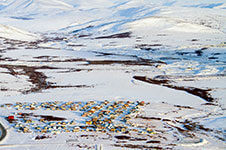Quintillion is a visionary company looking to improve connectivity and security in the US Arctic. We’ve done what no other telecommunications operator has done before: we built North America’s first and only subsea and terrestrial optic cable network in the Arctic. What’s in our pipeline? Our innovative team is working to expand our network to Asia and Europe and support space operations with the Quintillion HiLDA ground station at Utqiaġvik.
While we’ve seen many successes in recent years and look forward to a bright future ahead, we’ve faced some big challenges in the past. We’re proud of what we’ve overcome to become the company we are today, but we understand that our Alaskan clients and partners still have questions about our journey to this point.
In 2017, Quintillion’s past CEO Elizabeth Pierce raised more than $270 million from investors by presenting false service contracts with forged signatures on contracts worth more than $1 billion. She was sentenced to five years in prison after pleading guilty to eight counts of aggravated identity theft and one count of wire fraud. This left the rest of Quintillion’s leadership team to respond to Elizabeth’s actions and forge onwards toward our mission of creating an extensive fiber optic subsea cable network that connects Alaskans to each other and the rest of the world.
This situation put Quintillion in a difficult spot as we’ve had to rebuild our reputation and regain trust from our local Alaskan community. As we look to bring better service to Alaskans in every corner of the state and continue expanding our network, we move forward with recognition of the past and transparency in our plans for the future. Continue reading as Mac McHale, our Chief Revenue Officer, answers some FAQs and provides insight to those critical questions.
Want to learn more about network? Contact us.
Why should we trust Quintillion because of the past?
Our view is the past is the past and all that matters is what we do next. But we can’t ignore what happened. It happened. Our former CEO had some real lapses in judgment, and she did some things that were unlawful and unethical. As soon as our investors and our board of directors identified those issues, they took appropriate action and referred the matter to the department of justice. The former CEO is now in jail, doing time. Just was served, and there is some restitution at the end of that.
Although the investors were defrauded, they remained committed to the investment because they saw the power in the plan, in our strategy, and believed in the long-term opportunity, even though the guarantee of returns turned out to be somewhat spurious. They stuck with it, finished the build, and hired a great CEO, who surrounded himself with people he trusted to keep the company on track.
We’ve been operating in the black since 2017 and we’re continuing to grow in spite of COVID. We do the right things — we do them right, and we do enough of them. If we can continue to do that and perform the way we have — do what we say, do it on time, do it on budget — the sins of the past fade away. History is a great teacher and we’re taking those lessons. And we’ve got a great management team and a great board. We talk about big issues and small issues, and we’re all on the same page.
How did the issues from the past happen? What measures are in place now?
Even with proper checks and balances in place, certain actions were obfuscated and hidden. The company placed its trust in a person that did not honor and uphold that trust.
Now, we have a very clear vision of what we’re going to do, where we’re going to go, and how we’re going to get there. We have management and board-level meetings frequently to ensure these kinds of things don’t happen again.
Why is broadband so expensive in Alaska and the rural areas?
Alaska is a huge state two times the size of Texas with the population of Wyoming. Fiber is a leverageable asset and the shelf space is almost unlimited, but if you don’t have the population to consume that capacity, the cost per person is going to be higher.
That’s the main driver for the high cost of broadband in Alaska, and especially in rural communities. This is one of the reasons we’re not just focusing just on expanding in Alaska, but also expanding out and up — because that will leverage the network more when we go intercontinental and to space. We can use this expanded network to provide innovative and more affordable services across Alaska.
Why do you enjoy working for Quintillion?
I really like working for a company like Quintillion that has a clear vision and a plan. I can’t tell you how many people I run into who don’t have a plan. They only have a view of themselves and the service they provide. They can’t see past their own shoe tips. I always want to know what the plan was. Where are we going? What is theoretical and what is practical?
Our board meetings are very professional and thorough — not an inquisition — but very thorough and supportive. Questions that our CEO George and I ask a lot are what kind of company is Quintillion right now and what does it want to be? We always come back to the idea that we are at the leading edge of not just being a fiber company but being a global data management company.
What’s next for Quintillion?
Quintillion’s roadmap for the future is to continue furthering the in, out, and up strategy. What we’re talking about is serving more Alaskans with quality broadband and connecting them with each other and the world, “out” and “up” is about connecting continents in strategic locations and being able to take data from space for homeland defense purposes and things of that nature.
For the “In” part of our strategy, we plan to continue building up from the ground stations we’ve established in rural areas by putting up aggregation towers at each landing location to send wireless signals to rural areas. Our main goal is to improve our services so we can bring rural Alaskans high-quality, affordable, and reliable broadband.
We are also moving forward with expanding our network to other continents for the “Out” part of our strategy. First, we’re working on building fiber from Washington state to Japan. This will then connect to existing fiber connections in Alaska. We are also working on another connection from North Slope to the Thule Air Force base to Iceland and the UK. This will connect the North American Arctic, including Alaska, to both Asia and Europe.
For expanding “Up,” we will continue building a high latitude acquisition position in Utqiagvik and supporting polar-orbiting satellite technology to help with earth observations, monitoring climate change, navigation, and more. Our Quintillion HiLDA Ground Station is the highest latitude ground station in North America and serves as the foundation for supporting America’s economy and security advancement.
Have more questions about our past or future? Reach out to us.















